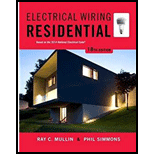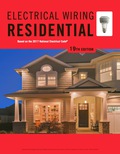
Electrical Wiring: Residental - With Plans (Paperback) Package
18th Edition
ISBN: 9781305416376
Author: MULLIN
Publisher: Cengage
expand_more
expand_more
format_list_bulleted
Concept explainers
Question
Chapter 25.1, Problem 12R
To determine
Choose the suitable options.
Expert Solution & Answer
Want to see the full answer?
Check out a sample textbook solution
Students have asked these similar questions
help on this question about three-phase half-wave rectifier? Also it envolves a little bit of signals and systems.
Don't use ai to answer I will report you answer
Correlation of experimental data for the average heat transfer coefficient for turbulent flow through tubes
is given by
NUD =hD/k=0.023 (Rep) 0.8 (Pr) 1/3
The Reynolds number, Re₁ = πD/v, is based on the tube diameter D, the average flow velocity ū and
the kinematic viscosity v. Consider the flow of air and of water through tubes of identical size. Assume
that the average velocity is the same for both fluids. If the average temperature for both fluids is 80°C,
determine the ratio of the heat transfer coefficient of water to that of air.
Chapter 25 Solutions
Electrical Wiring: Residental - With Plans (Paperback) Package
Ch. 25.1 - How many television outlets are installed in this...Ch. 25.1 - Which type of television cable is commonly used...Ch. 25.1 - What determines the design of the faceplates used?...Ch. 25.1 - Prob. 4RCh. 25.1 - From a cost standpoint, which system is more...Ch. 25.1 - Prob. 6RCh. 25.1 - Prob. 7RCh. 25.1 - Prob. 8RCh. 25.1 - Which article of the Code references the...Ch. 25.1 - It is generally understood that grounding and...
Ch. 25.1 - Prob. 11RCh. 25.1 - Prob. 12RCh. 25.1 - Which section of the Code prohibits supporting...Ch. 25.1 - When hooking up one CATV cable and another cable...Ch. 25.1 - Prob. 15RCh. 25.1 - Prob. 16RCh. 25.2 - How many locations are provided for telephones in...Ch. 25.2 - At what height are the telephone outlets in this...Ch. 25.2 - Sketch the symbol for a telephone outlet.Ch. 25.2 - Is the telephone system regulated by the NEC?...Ch. 25.2 - a. Who is to furnish the outlet boxes required at...Ch. 25.2 - Who is to furnish the telephones? _____Ch. 25.2 - Who does the actual installation of the telephone...Ch. 25.2 - How are the telephone cables concealed in this...Ch. 25.2 - Prob. 9RCh. 25.2 - What are the colors contained in a four-conductor...Ch. 25.2 - Itemize the code rule for the installation of...Ch. 25.2 - If finger contact were made between the red...Ch. 25.2 - What section of the Code prohibits supporting...Ch. 25.2 - The term cross-talk is used to define the hearing...Ch. 25.2 - Which section of the Code prohibits telephone...Ch. 25.3 - Prob. 1RCh. 25.3 - What style of chime is used in this residence?...Ch. 25.3 - a. How many solenoids are contained in a 2-tone...Ch. 25.3 - Explain briefly how two notes are sounded by...Ch. 25.3 - a. Sketch the symbol for a push button....Ch. 25.3 - Prob. 6RCh. 25.3 - What is the maximum volt-ampere rating of...Ch. 25.3 - What two types of chime transformers for Class 2...Ch. 25.3 - Is the extension chime connected with the front...Ch. 25.3 - a. What change in equipment may be necessary when...Ch. 25.3 - What type of insulation is usually found on...Ch. 25.3 - Prob. 13RCh. 25.3 - a. How many wires are run between the front hall...Ch. 25.3 - Why is it recommended that the low-voltage...Ch. 25.3 - a. Is it permissible to install low-voltage Class...Ch. 25.3 - a. Where is the transformer in the residence...Ch. 25.3 - a. How many feet of 2-conductor bell wire cable...Ch. 25.3 - Prob. 19RCh. 25.3 - Prob. 20RCh. 25.3 - What section of the Code prohibits supporting fire...Ch. 25.3 - Prob. 22RCh. 25.3 - What does the term Wi-Fi stand for? _____Ch. 25.3 - A Wi-Fi system is (required) (optional). (Circle...
Knowledge Booster
Learn more about
Need a deep-dive on the concept behind this application? Look no further. Learn more about this topic, electrical-engineering and related others by exploring similar questions and additional content below.Similar questions
- Don't use ai to answer I will report you answerarrow_forwardI have this code in matlab: clc; n=0:8; %20 harmonic indices jn=besselj(n,5);% 5 is the modulation index jnn=abs(jn); jn1 = 20.*log10(jnn*0.5); fc=1e+6; %carrier frequency fm=10e+3; %message frequency frq1 = (fc+n.*fm)*1e-06; frq2 = (fc-n.*fm)*1e-06; frequencies = [frq2,frq1]; %Lower and upper side magnitudes = [jn1,jn1]; %Magnitude of Jn corresponding to the frequencies % Plot figure; stem(frequencies, magnitudes, 'filled'); % Stem plot for spectrum visualization title('Magnitude Spectrum of FM Signal'); xlabel('Frequency (MHz)'); ylabel('Magnitude'); grid on; I am getting the lines opposite (the line should be traced from bottom to top not from top to bottom) as shown in the picture. How can I fix this?arrow_forwardDon't use ai to answer I will report you answerarrow_forward
- .I need in the way of spaces and not in shortened ways A 3-phase, 50 Hz, 132 kV overhead line transpose system of bundle conductors .a radius of conductor is 0.5 cm Calculate the total inductance of the line.) bi 4m C1 al 4m m birarrow_forward1B) Suppose the flip-flops are 74F74 devices and the AND gates are 74F08 devices. Let maxtpd,D=9ns, maxtsu,D=3ns, and maxtpd,AND=6ns. What is the maximum clock frequency at which the circuit can operate reliably? 2) Compare serial transmission and parallel transmission and discuss their advantages and disadvantages. 3) Explain briefly how the slave can protect itself from being overwhelmed by the master in I2 4) A hypothetical logic family has the following specifications. VOH=4.6V VIH=4.0V VOL=0.5V VIL=1.0V IOH=-1mA IIH=50μA IOL=8mA IIL=-0.6mA (4a) What are the noise margins? (4b) What is the fan-out capability? That is, suppose all gates are chosen from the same logic family, how many gates can an output gate reliably drive? 5) Explain briefly why USB device address and…arrow_forwardcan you drow set Vi=0, set Vo=0 B. For the FET amplifier circuit of Fig.(2), determine the topolgy, and the gain without and with feedback with the following circuit values: rao, and g 4mS Is Voo 60 K www 100 K 0.25 K IK Fig.(2) 20 K ww Voarrow_forward
- can you draw acircuit For the feedback circuit shown below VDD Set Vico set Vo=0 Is 100 K 26 K 2 K Q1 76 K IF 60 K 40 K Voarrow_forwardThe previous solutions are incorrect and unclear. If possible, please solve the question on the images .clearly. Thank you A 3-phase, 50 Hz, 132 kV overhead line transpose system of bundle conductors .a radius of conductor is 0.5 cm. Calculate the total inductance of the line. bi 4m m im birarrow_forwardA 3-phase, 50 Hz, overhead line has conductors placed in a horizontal plane as shown in the figure below. Conductor diameter is 2 cm. If the line length is 150 km, calculate the inductance, capacitance per phase of the line assuming complete transposition. a 20 cm b 20 cmarrow_forward
arrow_back_ios
SEE MORE QUESTIONS
arrow_forward_ios
Recommended textbooks for you
 EBK ELECTRICAL WIRING RESIDENTIALElectrical EngineeringISBN:9781337516549Author:SimmonsPublisher:CENGAGE LEARNING - CONSIGNMENT
EBK ELECTRICAL WIRING RESIDENTIALElectrical EngineeringISBN:9781337516549Author:SimmonsPublisher:CENGAGE LEARNING - CONSIGNMENT

EBK ELECTRICAL WIRING RESIDENTIAL
Electrical Engineering
ISBN:9781337516549
Author:Simmons
Publisher:CENGAGE LEARNING - CONSIGNMENT